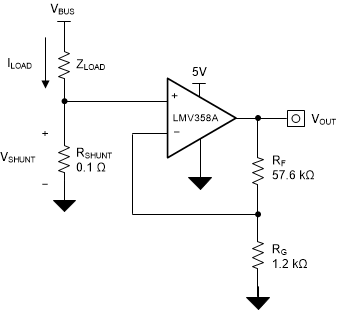SBOS923I December 2017 – July 2024 LMV321A , LMV324A , LMV358A
PRODUCTION DATA
- 1
- 1 Features
- 2 Applications
- 3 Description
- 4 Pin Functions and Configurations
- 5 Specifications
- 6 Detailed Description
- 7 Application and Implementation
- 8 Device and Documentation Support
- 9 Revision History
- 10Mechanical, Packaging, and Orderable Information
7.2.1 LMV3xxA Low-Side, Current Sensing Application
Figure 7-1 shows the LMV3xxA configured in a low-side current sensing application.
 Figure 7-1 LMV3xxA in a Low-Side, Current-Sensing Application
Figure 7-1 LMV3xxA in a Low-Side, Current-Sensing Application